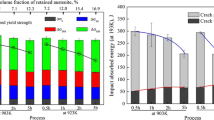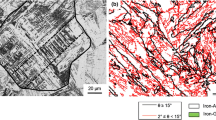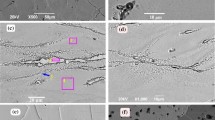Abstract
The alloy was reheated to 580 °C for tempering at rates of 2, 5, 10, 20, and 40 °C/s, respectively, after quenching. The amount, distribution, and stability of reversed austenite were investigated by X-ray diffraction (XRD) and electron back scatter diffraction (EBSD). The microstructure and cryogenic impact energy were studied by scanning electron microscope (SEM), transmission electron microscope (TEM) and Charpy V-notch (CVN) tests. The results showed that when the sample was heated at 10 °C/s, the volume fraction of reversed austenite exhibited maximum of 8%; the reversed austenite was uniform along all kinds of boundaries; the reversed austenite contained higher concentration of carbon which enabled it to be more stable. The cryogenic toughness of the alloy was greatly improved when heated at 10 °C/s, as the fracture surface observation showed that it mainly fractured in ductile rupture mode, which was consistent with the results of cryogenic impact energy.
Similar content being viewed by others
References
Thomas G. Electron Microscopy Investigation of Ferrous Martensite [J]. Metall Tran, 1971, 2: 373.
Bhadeshia H K D H, Dechamps M, Brown L M. The Structure of Twins in Fe-Ni Martensite [J]. Acta Metall, 1981, 29: 1473.
Clapp P C. How Would We Recognize a Martensitic Transformation If It Bumped Into Use on a Dark and Dusty Night [J]. Phys IV, 1995, 5: 11.
Morito S, Saito H, Ogawa T, et al. Effect of Austenite Grain Size on the Morphology and Crystallography of Lath Martensite in Low Carbon Steels [J]. ISIJ Int, 2005, 45: 91.
Bhadeshia H K D H, Edmonds D V. The Baintie Transformation in a Silicon Steel [J]. Metall Trans, 1979, 10A: 895.
Chen H C, Era H, Shimizu M. Effect of Phosphorus on the Formation of Retained Austenite and Mechanical Properties in Si-Containing Low Carbon Steel Sheet [J]. Metall Trans, 1989, 20A: 437.
Sakuma Y, Matumura O. Mechanical Properties and Retained Austenite in Intercritically Heat-Treated Bainite-Transformed Steel and Their Variation With Si and Mn Additions [J]. Metall Trans, 1991, 22A: 489.
Zarei Hanzaki A, Hodgson P D, Yue S. Retained Austenite Characteristics in Thermomechanically Processed Si-Mn Transformation-Induced Plasticity Steels [J]. Metall Trans, 1997, 28A: 2405.
Rao B V N. Direct Observation of Deformation-Induced Retained Austenite Transformation in a Vanadium-Coating DualPhase Steel [J]. Metallography, 1983, 16: 19.
Jimenez J A, Carsi M, Ruano O A, et al. Effect of Testing Temperature and Strain Rate on the Transformation Behavior of Retained Austenite in Low-Alloyed Multiphase Steel [J]. Materials Science and Engineering, 2009, 508A: 195.
Scott C P, Drillet J. A Study of the Carbon Distribution in Retained Austenite [J]. Scripta Materialia, 2007, 56: 489.
Seong B S, Shin E J, Han Y S, et al. Effect of Retained Austenite and Solute Carbon on the Mechanical Properties in TRIP Steels [J]. Physica, 2004, 350B(1/2/3): E467.
Kammouni A, Saikaly W, Dumont M, et al. Effect of the Bainitic Transformation Temperature on Retained Austenite Fraction and Stability in Ti Microalloyed TRIP Steels [J]. Materials Science and Engineering, 2009, 518A: 89.
Joo Hyun, Ryu Dong-Ik, Kim Hyoung, et al. Strain Partitioning and Mechanical Stability of Retained Austenite [J]. Scripta Materialia, 2010, 63(3): 297.
Fultz B, Morris J W. The Mechanical Stability of Precipitated Austenite in 9Ni Steel [J], Metallurgical Transactions, 1985, 16A(12): 2251.
ZHANG Fu-tian, LOU Zhi-fei, YE Yu-gong, et al. Behavior of Microstructure of Ni9 Steel Under Deformation-Fracture [J]. Acta Metallurgica Sinica, 1994, 30(6): 239 (in Chinese).
Marschall C W, Hehemann R F, Iroiano A K. The Characteristics of 9% Nickel Low Carbon Steel [J]. Transaction of Americal Society for Metals, 1962, 55: 135.
Fultz B, Kim J I, Kim Y H, et al. The Chemical Composition of Precipitated Austenite in 9Ni Steel [J]. Metallurgical Transactions, 1986, 17A(6): 967.
Kim K J, Schwartz L H. Effects of Intercritical Tempering on the Impact Energy of Fe-9Ni-0. IC [J]. Materials Science and Engineering, 1978, 33A(8): 5.
Strife J R, Passoja D E. The Effect of Heat Treatment on Microstructure and Cryogenic Fracture Properties in 5 Ni and 9 Ni Steel [J]. Metallurgical Transactions, 1980, 11A(8): 1341.
Fultz B, Morris J W. A Mössbauer Spectrometry Study of the Mechanical Transformation of Precipitated Austenite in 6Ni Steel [J]. Metallurgical and Materials Transactions, 1985, 16A: 173.
Leem Dong-seok, Lee Yong-deuk, Jun Joong-hwan, et al. Amount of Retained Austenite at Room Temperature After Reversed Transformation of Martensite to Austenite in an Fe13%Cr-7%Ni-3%Si Martensitic Stainless Steel [J]. Scripta Materialia, 2001, 45: 767.
Tschegg E K, Suresh S. Mode III Fracture of 4340 Steel: Effects of Tempering Temperature and Fracture Surface [J]. Metall Trans, 1988, 19A: 3035.
Dyson D J, Holmes B. Effect of Additions on the Lattice Parameter of Austenite [J]. Journal of the Iron and Steel Institute, 1970, 208: 469.
Sugimoto Ki, Lida T, Sakaguchi J, et al. Retained Austenite Characteristics and Tensile Properties in a TRIP Type Bainitic Sheet Steel [J], ISIJ International, 2000, 40(9): 902.
Sugimoto Ki, Usui N, Kobayashi M, et al. Effects of Volume Fraction and Stability of Retained Austenite on Ductility of TRIP-Aided Dual-Phase Steels [J]. ISIJ International, 1992, 32(12): 1311.
SHI Chang-xu. The Decomposition of Retained Austenite in High Strength Steel During Tempering [J]. Acta Metallurgica Sinica, 1956, 1(4): 383 (in Chinese).
Author information
Authors and Affiliations
Corresponding author
Rights and permissions
About this article
Cite this article
Zhang, K., Tang, D. & Wu, Hb. Effect of Heating Rate Before Tempering on Reversed Austenite in Fe-9Ni-C Alloy. J. Iron Steel Res. Int. 19, 73–78 (2012). https://doi.org/10.1016/S1006-706X(13)60011-4
Received:
Published:
Issue Date:
DOI: https://doi.org/10.1016/S1006-706X(13)60011-4




